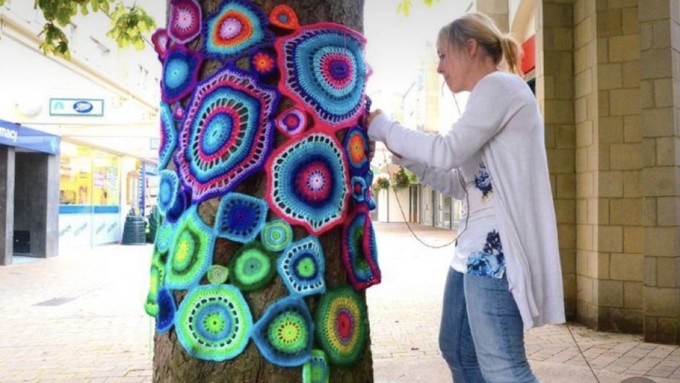
Sacramento textile artists host colorful array at Shepard Center

Ever been to a yarn bombing? Local textile artists will attach yarn pieces to McKinley Park's trees on Saturday morning. Courtesy SCTA
On Saturday, June 8, the Sacramento Center for the Textile Arts hosts a triple-header of activities. It starts with the group’s annual “Yarn Bombing in Bloom” installation at 9 a.m. Members will decorate trees around Shepard Center with handmade yarn flowers and other crocheted decorations.
Local textile artists – specifically knitters, crocheters and needle workers – will attach yarn pieces to trees with more yarn. The installation is expected to stay on display for a month, adding some extra color to the park’s trees.
Activities then shift from a rainbow of yarn to deep, dark denim blue. Starting at 10 a.m. Saturday, the group will hold its “Indigo Dip Dye Day” on the center’s patio. The public is invited to dye their own bandanna or fat quarters, but snag a reservation right away. Those dye tubs can get crowded.
The Indigo Dip Dye Day will be led by indigo expert LuAnne Hansen, who also provides all instruction. Fee for this one-hour workshop is $27 and includes all materials. Time blocks are staggered through 2 p.m. (Make sure to wear old clothing; indigo stains!)
After indigo comes the white elephants, or in this case, “Art Elephants.” From 10 a.m. to 2 p.m. inside Shepard Center, SCTA hosts its annual “Art Elephant Sale,” with dozens of vendors offering unique items. Find materials and tools for all sorts of arts and crafts plus some unusual results of projects. Admission is free.
Located in the north panhandle of McKinley Park, Shepard Center is at 3330 McKinley Blvd., Sacramento.
Details including a link for Indigo Dye reservations: https://sactextilearts.org/.
Comments
0 comments have been posted.Sacramento Digs Gardening to your inbox.
Food in My Back Yard Series
April 1: Don't be fooled by these garden myths
March 25: Fertilizer tips: How to 'feed' your vegetables for healthy growth
March 18: Time to give vegetable seedlings some more space
March 11: Ways to win the fight against weeds
March 4: Potatoes from the garden
Feb. 25: Plant a fruit tree now -- for later
Feb. 18: How to squeeze more food into less space
Feb. 11: When to plant? Consider staggering your transplants
Feb. 4: Starting in seed starting
Sites We Like
Garden Checklist for week of March 30
Your garden doesn’t mind April showers. Get busy now to enjoy those future flowers.
* Get ready to swing into action in the vegetable garden. As nights warm up over 50 degrees, start setting out tomato, pepper and eggplant transplants.
* From seed, plant beans, beets, cantaloupes, carrots, corn, cucumbers, melons, pumpkins, radishes and squash. (Soak beet seeds overnight in water for better germination,)
* Plant onion sets.
* In the flower garden, plant seeds for asters, cosmos, celosia, marigolds, salvia, sunflowers and zinnias.
* Transplant petunias, zinnias, geraniums and other summer bloomers.
* Plant perennials and dahlia tubers for summer bloom.
* Transplant lettuce and cabbage seedlings.
* April is the last chance to plant citrus trees such as dwarf orange, lemon and kumquat. These trees also look good in landscaping and provide fresh fruit in winter.
* Smell orange blossoms? Feed citrus trees with a low dose of balanced fertilizer (such as 10-10-10) during bloom to help set fruit. Keep an eye out for ants.
* Apply slow-release fertilizer to the lawn.